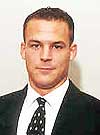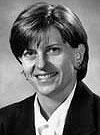The six member schools of College Hockey America enter the 2002-03 season with a common goal: coming out of Kearney, Neb., with the conference’s first-ever automatic bid to the NCAA postseason.
“We’re all working to get ready for the tournament, no doubt about it,” said Alabama-Huntsville head coach Doug Ross.
We’re all working to get ready for the tournament, no doubt about it.
— UAH coach Doug Ross, on the CHA’s first NCAA autobid
Only one CHA member school has made the NCAAs — Niagara, back in 1999-2000, when the Purple Eagles upset New Hampshire in a first-round matchup that still stands as the CHA’s finest hour. The last two years, however, Wayne State has captured the conference tournament, only to be left on the outside looking in when at-large bids were handed out.
At Niagara’s Dwyer Arena last March, one thing was clear: the tournament was important to every player and coach, because they all knew that no one in the league was going on to the NCAAs.
At the time, UAH’s Steve Milosevski, who’d sprained his ankle in the tournament semifinal against Bemidji State and was apparently going to play in the finals, said “This is all we have left to play for this season. What am I going to do–go home now?”
Something to play for … that’s all this conference has ever really wanted.
The team with perhaps the most to play for is Wayne State. The boys from Hockeytown sure have an interesting schedule lined up: they will play in five arenas across the metro area, including Joe Louis, in an effort to fire up their fans. WSU’s long had a hard time garnering fan support, although watching them the last two years leaves one wondering why.
The Warriors are the obvious preseason pick to be No. 1 going into Kearney. They return virtually their entire roster, most importantly David Guerrera in goal. Guerrera is the class of CHA netminders, and with the joyous return of Marc Carlson from a year spent battling cancer, he won’t be asked to shoulder the entire load as he was last year. A stout defense will support those goalies, led by Tyler Kindle.
On offense, the Warriors bring back their top players, including Dusty Kingston and Jason Durbin, who will captain this year’s squad. One looks on down through the lines and realizes this: the tough nonconference schedule may be gone, but the tough, gritty players are still there.

Serratore
Bemidji State head coach Tom Serratore had one point to drive home: “Wayne State and [Alabama-]Huntsville are the class of our conference this year … But the rest of us are certainly going to have something to say about it.”
On paper, Serratore is right: the Chargers have reloaded.
The thing that killed the Chargers in 2001-02 was defense. Senior goalie Mark Byrne suffered two broken wrists in a nasty fall while washing windows last summer, but he stayed off of unsteady ladders and comes back primed to extend his school record for shutouts in a career. Junior netminder Adam MacLean and freshman Scott Munroe promise to provide depth in net, and according to coach Doug Ross, all three have a shot at playing.
“Oh, I’ll play all three of them,” said Ross. “Certainly Byrnie’s our horse, but MacLean and Munroe will get some time. Scotty’s a big kid, and that’s what we’ve been needing in net.”
Another area where size was needed was on defense. The Charger blueliners were ravaged by injuries last season as then-freshman Doug Watkins was the only Charger defenseman not to miss time to injury at some point. UAH brings back the core of its defense with the top pair of Ryan Leasa and Tyler Butler, the return of Ian Fletcher from injury, Watkins, David Halliwill, Ryan Brown, and two freshmen in Jeremy Schreiber and Jeff Winchester, whom Ross labeled “a monster” due to his size.
The Chargers return the bulk of their offensive firepower, losing only Jessi Otis to graduation. Mike Funk returns from a redshirt year to captain the squad. His size should add a needed boost to the Chargers in front of the opposing net. The lines of Steve Charlebois, Jason Hawes, and Joel Bresciani and Karlis Zirnis, Jared Ross, and Craig Bushey are almost assuredly going to return for this season, with the other positions up for grabs. Competing for ice time will be freshmen Bruce Mulherin, Todd Bentley, and Luke Flaig.
Tom Serratore’s Bemidji State squad is a solid bet to come in third. They have scoring with Marty Goulet, Riley Riddell, and Andrew Murray, which Serratore likes.
“I think our offense is decent, [although] we’re not up there with Wayne State and Huntsville,” said Serratore. “Murray and Riddell are going to be really good as sophomores for us, and we hope those guys make the next step. We really need a third line this year, and that’s what we’re trying to find. We’ve got some good guys coming back, and our freshmen will contribute. They’re going to be young, and that will hurt us at times, but I think they’ll all be great additions.”
The concern for BSU is the play in net. Grady Hunt was good but inconsistent last year, and Dannie Morgan unfortunately wasn’t much help when Hunt was having a rough stretch. Agreed Serratore, “Grady’s our No. 1 going into the season. Dannie and Kelly Shields may have something to say about that. Consistency is what we need in there, and I think we can find it.”
The defense for Bemidji should be sound, as they lost only Mark Phenow on the blue line. However, Jamie Mattie was supposed to be a big addition for the Beavers, but was declared ineligible due to signing a contract to play major juniors.
As Serratore said, “It’s a blow for us but it’s really a blow for Jamie. There was no competitive advantage for him playing juniors, but signing a contract is what did him in. The rules are the rules, though.” The Mattie situation is a sad one for BSU and the CHA as a whole, as the conference would have been strengthened with a player of his caliber.
The surprise pick here for fourth place in the CHA is Findlay. Call me crazy, but Rigel Shaw is a star for the Oilers, and his offensive contributions should continue to grow as he acclimates his play to Division I. The big loss for the Oilers is Brant Somerville, their career scoring leader.
Findlay coach Craig Barnett thought that pick was a bit high, suggesting sixth. “After last season’s performance, we certainly deserve it. I want to use last year as a motivation for this year.”
Nothing doing — the talent level is too high for a last-place finish.
You know it’s coming … you can’t talk about Findlay without talking about the goalie situation. Barnett said that Kevin Fines and Jamie VandeSpyker will have an “even” shot at playing this season, which seems appropriate. VandeSpyker looked overmatched at times last season, and Fines may be more solid in goal.
The top pickup for the Oilers is Sean Kotary, who comes to Ohio with a fair amount of experience. Said Barnett, “He played at Bowling Green two years ago, and he’ll get to play right away for us because he played juniors last year in Des Moines. He’s our first-ever NHL draft pick, and we’re real excited about him. This is a second opportunity for him.”
The Oilers do have a hole on the blue line from the loss of Somerville. One player who really could pick up the slack is Paul Prefontaine, a freshman defenseman from Alberta.
“Paul Prefontaine is a very skilled, mobile defenseman,” said Barnett. “He’s a guy that should help us with our transitional game and should help us begin to replace Brant Somerville.
“No freshman will ever replace someone like Brant, but in terms of talent, Paul’s going to be a great guy for breaking the puck out from our end.”
Air Force always has a tough row to hoe. Because of the nature of the Academy, the Falcons are usually younger as they come straight out of high school, and obviously Air Force is limited to recruiting Americans. While this does present some challenges, the Falcons still have a good set of players this season.
Frank Serratore’s charges will be anchored by their netminders. Due to injuries and inexperience amongst the backups, Mike Polidor shouldered nearly all of the load last season as a sophomore. Now the junior will have help in the form of freshman David Goodley, one of the Falcons’ exciting freshmen.
“David Goodley gives us depth in goal that we were lacking [last year],” said Serratore. “He should be a quality second guy behind [Polidor].”
Scott Zwiers and Andy Berg lead the offensive charge, and they’re helped by Spanky Leonard, Justin Hamilton, and Shane Saum. As Serratore says, “Wayne State was the only team in the nation hotter than us [at the end of last year]. We really think our freshman class will contribute right away and give us a shot.”
And they are good, but not quite good enough to overtake Findlay.
Coming in last but not least is Niagara. Dave Burkholder begins his second season as coach of the Purple Eagles having made his presence known in the offseason, dumping over half a dozen players from his roster. While Burkholder is undoubtedly trying to mold his program, it’s not clear what the cost is going to be to his team. Regardless of attitude problems, it’s not clear that you can drop as much talent as the Purple Eagles have done and still compete.
One place where Burkholder seems ready to shake things up is the one he knows best: goaltender. Burkholder was an All-American at RIT in 1983, and he doesn’t seem content with the status quo.
Burkholder said, “We’re looking for battlers. Goalies, by far, have to be the mentally toughest competitors on our team. We believe increased internal competition will bring out the best in them, and, as importantly, give us the quality depth we lacked down the stretch.”
Rob Bonk has been solid in his two seasons, and as a big goalie, is very valuable. However, Burkholder’s comments suggest that Ryan MacNeil and Jeff VanNyatten both have a shot. MacNeil is reportedly recovered from the injury that ended his season last year, but he could come in third behind VanNyatten, one of the best prospects in Ontario Junior B.
Senior Chris Sebastian holds down the Purps’ blue line. Burkholder says that Sebastian’s one of the fastest players in all of D-I, and with 56 points already in his career, he seems primed to have a stellar senior season. Andrew Nahriniak and Dave Hominuk will also provide solid play in the defensive end.
Hannu Karru and Barrett Ehgoetz will have to pick up the offensive load for Niagara, as many of the ex-Eagles were forwards. Bernie Sigrist will come back from a season of injuries that saw his scoring drop from 28 points as a freshman to just 11 as a sophomore. The Eagles will be able to stop opposing offenses, but there are concerns about their ability to net goals.
Despite the improvement as UAH should see from recruits and injury returnees — after all, the return of Funk and Fletcher is like adding two more players — Wayne State is still top dog. UAH should be a close second, as a tough nonconference schedule (including WCHA powers Wisconsin, Denver, and Minnesota) should provide a lot of experience, just as a similar early schedule did for Wayne State last year.
Bemidji State is the best of the rest, though Findlay, Air Force, and Niagara all come up close behind. But as Serratore said, “There’s only a goal or a goal and a half difference between the first- and sixth-place team in our league. I don’t know how it’s going to come out — on paper it’s Wayne State and Huntsville, but we’ll all have a lot to say about that. It’s going to be a great year.”
It will indeed. See you in Kearney, if not before.


